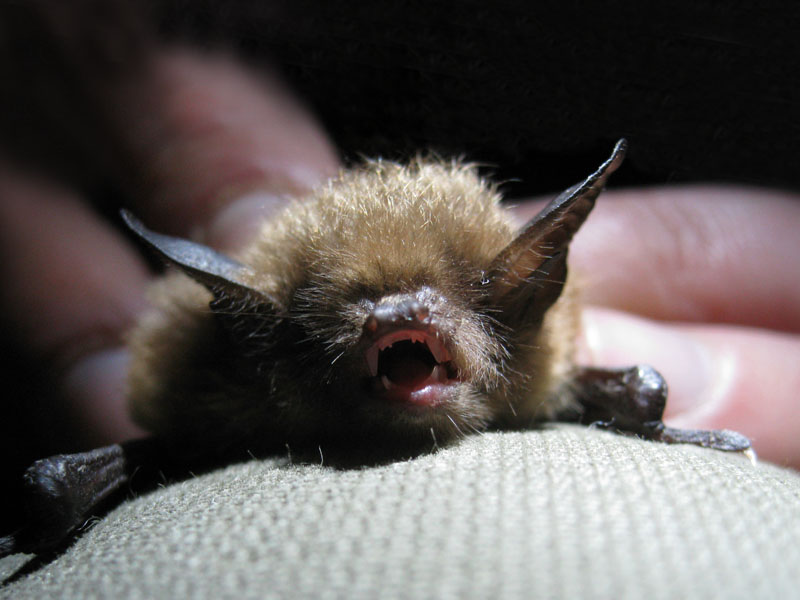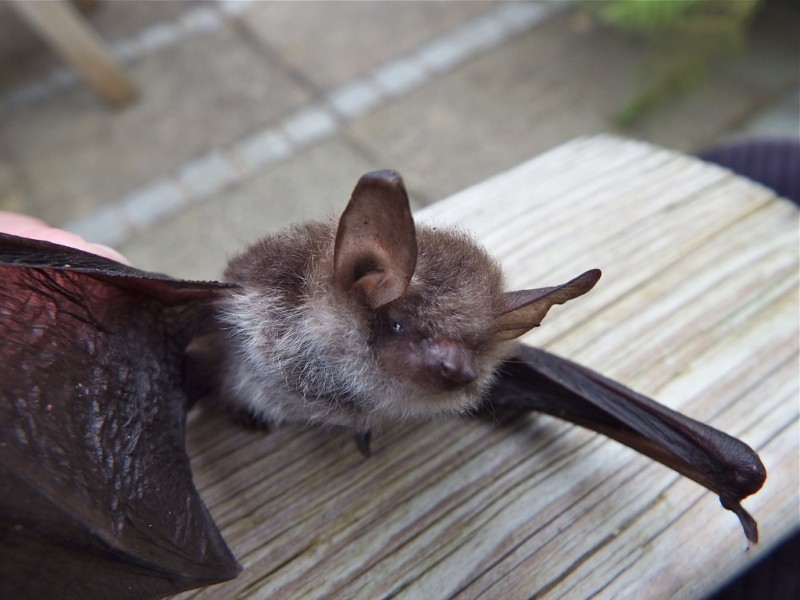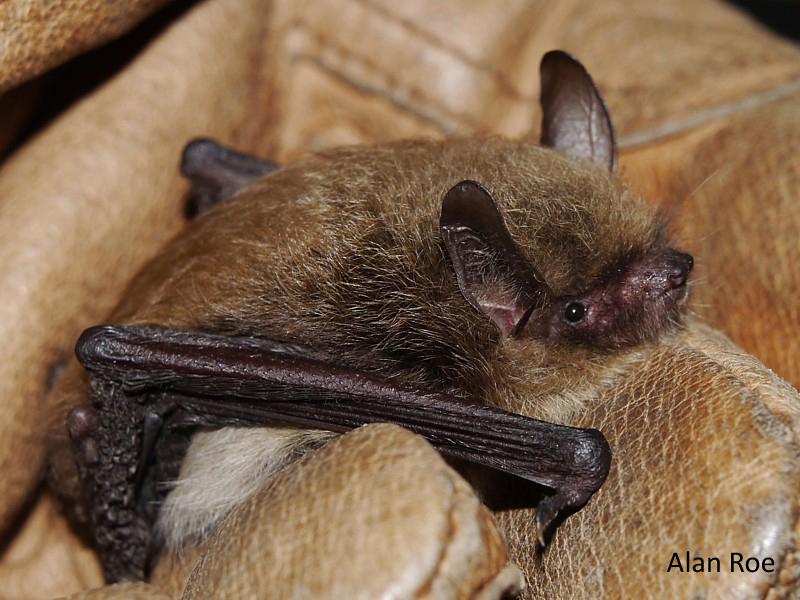Legal Status
- Wildlife Act 1976 / 2000
- EU Directive 92/43 Annex IV
- Bern Convention Appendix II
- Bonn Eurobats Convention Appendix II
Key Identification Features
The whiskered bat is one of Ireland’s smaller rarer bats and is Europe’s smallest myotis bat species. They have dark brown shaggy fur on their backs and upperparts with a greyish to white coloured underbelly. Adult whiskered bats measure up to 4.8cm head and body combined with a 4cm long tail. The feet are very small for a bat species. At their heaviest in the autumn adults can weigh up to 8 grams but will slim down to between 4 and 5 grams in the summer after their winter hibernation period. Whiskered bats have dark almost black faces which contain long sensory whiskers around the lips. Their ears are also black in colour, are moderately long triangular in shape and quite pointed at the tips. Wing design is broad and pointed which reflects their flying style which is relatively fast and straight when above trees with rapid fluttering wing beats used to maneuver, the whiskered bat can also glide for long distances. Wing membranes are a dark grey to black colour and span up to 25cm for fully grown adults. Ultrasonic calls are used to detect its prey in the range of 40 – 65 kHz. When communicating within the roost the whiskered bat emits long high pitched scolding sounds and will emit a high range twittering noise if disturbed. The whiskered bat is similar in appearance to Ireland’s pipistrelle species and is closely related to the brandt’s bat found on mainland Europe.
Habitat
The preferred habitat type of the whiskered bat is in open meadows and wooded landscapes often near freshwater bodies. They have a tendency to roost in houses particularly older ones so they can also be found in parks, gardens and villages. The summer roosts are generally composed of maternity colonies containing breeding females, their offspring and young non-breeding juvenile females. Males will remain solitary during the summer period. Colony sizes can be quite small containing less then eight individuals and are usually found sharing roosting sites with other species such as pipistrelles, natterer’s bats and brown long – eared bats. Summer roosts can be found in tree hollows but are often located in buildings within walls and lofts and can even be found in stonewalls. Winter roosts used for the hibernation period and breeding season are mostly found in underground sites such as caves and old mines with the whiskered bat preferring slightly cooler temperatures of 2 – 8 degrees Celsius, which is lower than other Irish bat species so they can often be found clustered together in groups closer to the entrance of shared roost sites.
Food and Feeding Habits
The whiskered bat species emerges early in the evening to hunt at around half an hour after sunset and may remain active all night with a peak in activity after sunset and just before sunrise returning to the roost at dawn. Regular hunting areas are used often over open mixed woodlands along hedgerows or over fresh water bodies. Two different hunting techniques are used by this species, they will catch small winged insects while in flight such as moths, mayflies and midgets while they fly low over the ground. Or the bat can glean flightless insects such as spiders and beetles directly off vegetation or on the ground. Whiskered bats are considered to be a sedentary bat species who will not travel long distances from the roost to their hunting grounds so an individual’s home range may be quite small.
Reproduction and Life Cycle
The mating season for the whiskered bat occurs while they are in the winter hibernation roost from autumn to spring with mating increasing as the hibernation period progresses. By May each year the females will separate from the males to establish separate maternity colonies where the young will be born by June or July. Litter sizes are usually a single offspring for this species. Young bats are weaned for six weeks and will by this time be capable of solo flight and can forage outside of the roost for themselves. Like all Irish bat species parental care is given by the mother only. Young female bats will not become sexually mature until they reach fifteen months of age. On average the lifespan of a whiskered bat in the wild in Ireland is only 4 years although some individuals have been recorded as having reached a 20-year lifespan.
Current Distribution
The modern day bat family tree now contains 950 different species divided into 17 families. The whiskered bat species belongs to the Vespertilionidae family in the Chiroptera order which include the brown long eared bat, daubenton’s bat, natterer’s bat and the leisler’s bat species found in Ireland. The oldest fossils which gave rise to modern bats date from 50 million years ago. Past climatic changes such as the last Ice Age seriously affected the number and range of bats but they can now be found in most habitats throughout the world except for land areas near the poles. Bats are believed to have evolved from small insect hunting mammals that occupied the tree canopy of forested areas of the Eurasian continent. The whiskered bat is now widespread throughout Europe, central Asia and its range currently extends eastward to Japan. They are absent from the colder climates of north Scotland and northern Scandinavia. The whiskered bat was known to the present in Britain 6,000 years ago and may also have been established in Ireland at this time but they were not scientifically identified here until the year 1852. The whiskered bat is one of our rarest mammal species with an estimated current population of fewer than one thousand individuals.
Conservation Issues
The main threats to the small population of Irish whiskered bats comes from the destruction of their summer and winter roost sites by building renovation and the treatment of attic timbers with chemical preservatives. As the litter sizes of the bat are usually a single offspring any losses are harder to recover from, also female whiskered bats do not become sexually mature until they reach fifteen months of age adding to their slow recovery rate. Their traditional habitats of open woodlands have been in decline as is their preferred insect food items due to the widespread use of agricultural pesticides which can reduce insect populations locally. Recent re-forestation initiatives will in the future increase the habitat range of the whiskered bat once these plantations mature. The whiskered bat’s status has been designated as indeterminate but most likely vulnerable and is now protected under national, European and international legislation which reflects the importance of this species.



